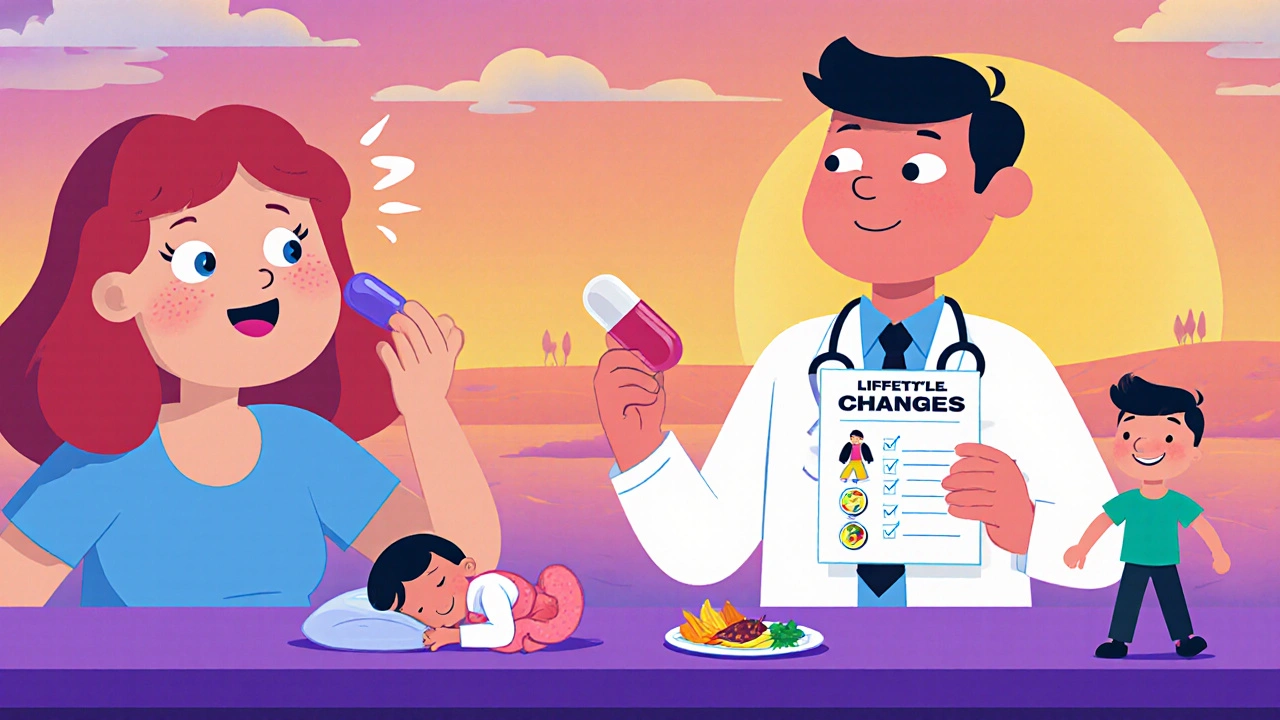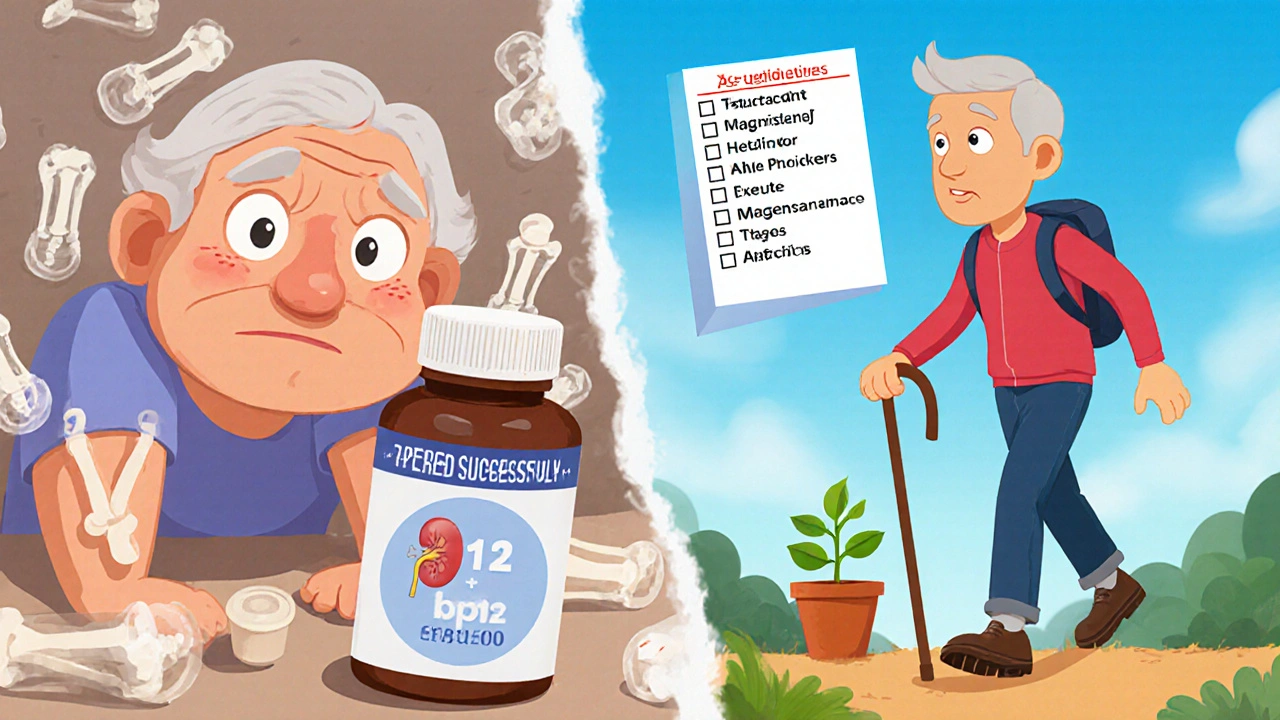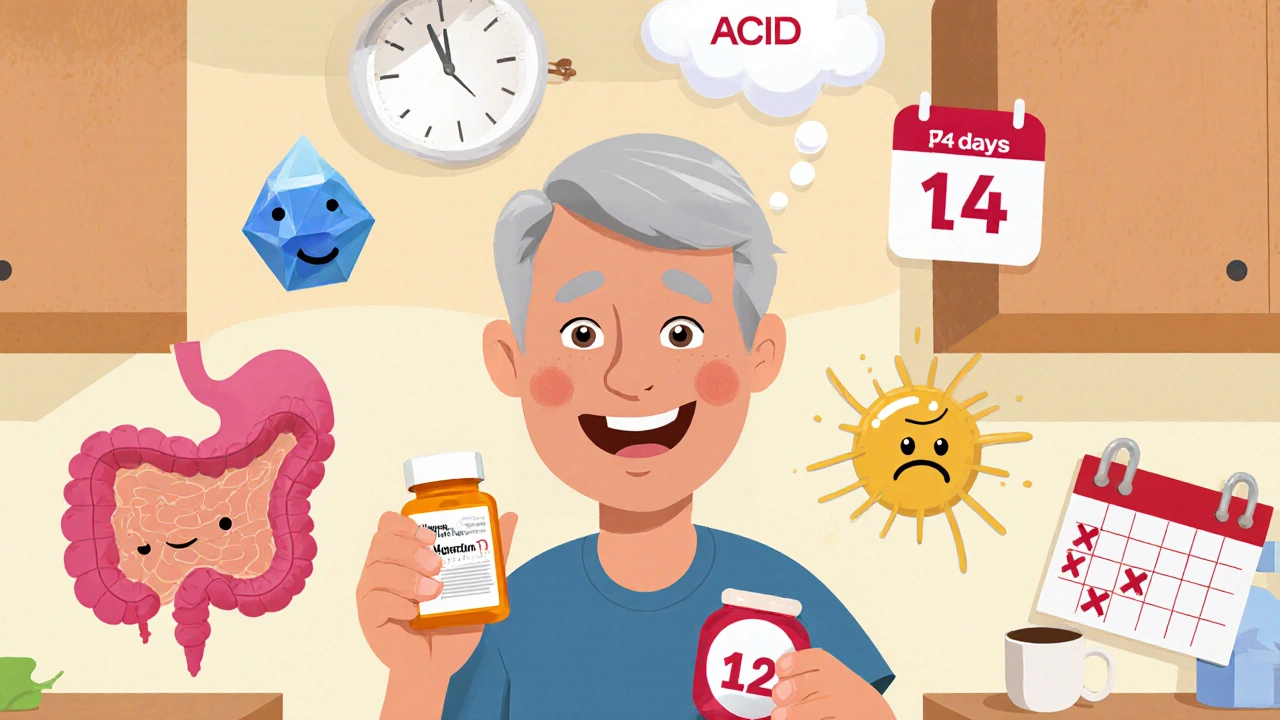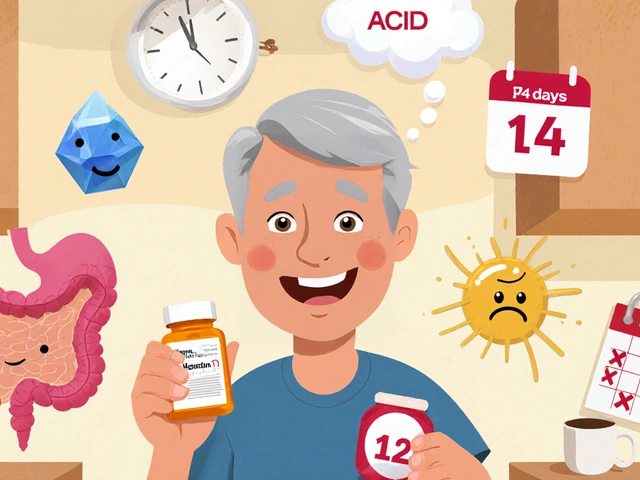Proton pump inhibitors are among the most common medications in the U.S., with over 22 million people using them daily. They work wonders for heartburn, ulcers, and acid reflux-fast, effective, and often life-changing for those with severe symptoms. But what happens when you take them for months or years? The truth is, many people stay on PPIs far longer than they need to, and the risks add up quietly over time.
How PPIs Work-and Why They’re So Popular
Proton pump inhibitors (PPIs) like omeprazole, esomeprazole, and pantoprazole block the final step of stomach acid production. They’re not quick fixes like antacids-they take 1 to 4 days to build up full effect. That’s why they’re prescribed for ongoing conditions: erosive esophagitis, Barrett’s esophagus, or ulcers caused by NSAIDs or H. pylori.
For many, they’re a game-changer. Healing rates for severe esophagitis exceed 90%. But that effectiveness is also part of the problem. Because they work so well, people assume they’re harmless. A 2023 study in US Pharmacist found that 15 million Americans take prescription PPIs long-term, and another 7 million use over-the-counter versions beyond the FDA’s recommended 14-day limit-often for years.
The Real Long-Term Risks (Backed by Evidence)
The FDA has issued seven safety warnings on PPIs since 2010. Not all are equally likely, but some are well-documented.
- Low magnesium (hypomagnesemia): Rare, but serious. It can cause muscle cramps, irregular heartbeat, and seizures. The FDA now requires doctors to check magnesium levels after one year of continuous use.
- Increased risk of bone fractures: Especially hip fractures in older adults. A 2017 study showed people taking PPIs for 6-8 years had a 55% higher risk. The good news? That risk drops back to normal within two years of stopping.
- Vitamin B12 deficiency: PPIs reduce stomach acid, which is needed to release B12 from food. About 10-15% of long-term users develop deficiency. Symptoms include fatigue, tingling in hands and feet, and memory problems.
- C. diff infection: Stomach acid normally kills harmful bacteria. With less acid, C. difficile can thrive. Hospitalized patients on PPIs have a 1.7-2 times higher risk of this dangerous diarrhea.
- Acute interstitial nephritis: A rare kidney inflammation that can lead to chronic kidney disease if untreated. The FDA flagged this in 2016, and cases have been confirmed in long-term users.
Other risks-like dementia, heart disease, or stomach cancer-have been suggested in observational studies. But experts like Dr. William Ravich from Yale Medicine point out: many of these studies didn’t control for other factors. People on long-term PPIs often have other health problems: obesity, smoking, diabetes. That makes it hard to say if PPIs are the cause-or just a marker of poor health.
Rebound Acid: The Hidden Trap of Stopping Suddenly
If you’ve been on PPIs for more than a few months and stop cold turkey, you’re likely to feel worse than before. That’s rebound acid hypersecretion. Your stomach, used to being silenced, overcompensates by producing even more acid.
Studies show 40-80% of long-term users experience this. Symptoms include intense heartburn, bloating, nausea-sometimes worse than original symptoms. It can last weeks. Many people think the PPI stopped working, so they restart it. And the cycle continues.
This isn’t addiction. It’s physiology. Your body adapts. That’s why stopping needs a plan.

When and How to Stop PPIs Safely
The American College of Gastroenterology says: Use the lowest dose for the shortest time possible. But in practice, most patients never get a check-in.
Here’s what works:
- Ask yourself: Why are you still on it? Did you get diagnosed with GERD? Or did you just start taking it for occasional heartburn and never stop?
- Try tapering. Don’t quit cold turkey. Reduce your dose by half every 1-2 weeks. For example, go from 20mg daily to 10mg daily, then 10mg every other day.
- Switch to on-demand use. Once you’re on a low dose, only take it when symptoms return. Many people find they only need it 2-3 times a week.
- Use alternatives for mild symptoms. H2 blockers like famotidine (Pepcid) or ranitidine (when available) work well for occasional heartburn. Antacids like Tums or Maalox give instant relief.
- Address root causes. Weight loss, avoiding late meals, cutting caffeine and alcohol, and elevating your head while sleeping can reduce acid reflux significantly.
For most people with mild GERD, lifestyle changes and intermittent use are enough. You don’t need to be on a PPI every day for life.
Who Should Stay on PPIs?
Not everyone should stop. Some conditions require ongoing treatment:
- Severe erosive esophagitis that hasn’t fully healed
- Barrett’s esophagus (a precancerous condition)
- History of bleeding ulcers
- Long-term NSAID users (like those on daily aspirin or ibuprofen for arthritis)
If you’re in one of these groups, talk to your doctor about the lowest effective dose. Don’t stop without medical advice.
Over-the-Counter PPIs: The Silent Overuse Problem
OTC PPIs like Prilosec OTC and Nexium 24HR are labeled for 14-day use, no more than once every 3 months. But a 2023 survey found 25% of users take them daily for months or years without seeing a doctor.
Why? Because they’re easy to buy, cheap, and feel harmless. But the same risks apply. And if you’re self-treating for heartburn, you could be masking something serious-like a stomach ulcer, gallstones, or even esophageal cancer.
Rule of thumb: If you need OTC PPIs more than 3 times a year, talk to a doctor. Don’t just refill the bottle.

What’s Next? New Drugs and Better Guidelines
Researchers are developing new acid-reducing drugs called potassium-competitive acid blockers (P-CABs), like vonoprazan. Early data suggest they work faster and may have fewer long-term side effects. But they’re not yet widely available in the U.S., and long-term safety data are still limited.
Meanwhile, guidelines are shifting. The American Gastroenterological Association now recommends “drug holidays”-trying to stop PPIs every 6-12 months-to see if you still need them. About 30-50% of long-term users can successfully stop without symptoms returning.
The goal isn’t to scare people off PPIs. It’s to make sure they’re used when needed-and not when they’re just sitting in the medicine cabinet, quietly causing harm.
Final Thoughts: Balance Is Key
PPIs are powerful tools. For the right person, they’re essential. For too many others, they’ve become a crutch.
If you’ve been on a PPI for more than 8 weeks without a clear diagnosis, it’s time to ask: Do I still need this? Can I try tapering? Are there lifestyle changes I haven’t tried?
Stopping isn’t about fear. It’s about reclaiming control. Your stomach doesn’t need to be permanently quiet. Sometimes, it just needs a break.
Can I stop taking PPIs cold turkey?
No, stopping suddenly after long-term use often causes severe rebound acid reflux, making symptoms worse than before. Instead, work with your doctor to gradually reduce the dose over weeks or months.
How long is too long to be on a PPI?
For most conditions like GERD, 4-8 weeks is enough. If you still need it after that, your doctor should reassess your diagnosis and consider alternatives. Long-term use (more than a year) should only continue if there’s a clear medical reason, like Barrett’s esophagus or recurrent ulcers.
Do PPIs cause kidney damage?
PPIs can cause acute interstitial nephritis-a rare but serious kidney inflammation-in a small number of users. While some studies link long-term use to a higher risk of chronic kidney disease, the evidence isn’t conclusive. Regular monitoring is advised for those on PPIs for more than a year.
Can PPIs lead to vitamin deficiencies?
Yes. Long-term use can reduce absorption of vitamin B12, magnesium, calcium, and iron. Vitamin B12 deficiency affects up to 15% of users after two years. Blood tests can detect these, and supplements may be recommended if levels are low.
Are there natural alternatives to PPIs?
Lifestyle changes are the most effective natural approach: lose weight if overweight, avoid eating 3 hours before bed, cut out trigger foods (spicy, fatty, or acidic foods), quit smoking, and elevate the head of your bed. For mild symptoms, H2 blockers like famotidine or antacids can be used on an as-needed basis.
Why do doctors prescribe PPIs so often?
PPIs are highly effective and marketed as safe. Many patients request them, and doctors may prescribe them to avoid follow-up visits or due to pressure. Studies show up to 70% of PPI prescriptions lack clear medical justification, especially for mild dyspepsia or unconfirmed GERD.
Next Steps: What to Do Today
- If you’ve been on a PPI for more than 8 weeks, schedule a check-up. Ask: “Do I still need this?”
- If you’re on OTC PPIs and use them more than 3 times a year, talk to your doctor.
- Keep a symptom diary for two weeks. Note when heartburn happens and what you ate or did before it.
- Try one lifestyle change: stop eating late, or cut out caffeine after noon.
- Don’t stop cold turkey. Work with your provider on a safe taper plan.
PPIs aren’t the enemy. But they’re not harmless either. The goal isn’t to avoid them entirely-it’s to use them wisely, and only when you truly need them.

